|
1.
FRANCOPHONE
WEST AFRICA
Log prices remain firm
Log prices remained firm and producers were confident of a rising trend thr ough the first quarter of 2006. Sapele prices held onto the recent higher level and producers forecast further price increases as soon as European buyers return to the market looking for spring and summer stocks.
Currently there are substantial supplies of sapele and sipo from Republic of Congo and Central African Republic (CAR). There are reports of occasional discounted sales of mixed grade logs at around .15-20 below the usual price. Exporters indicate that sipo is in good demand but price negotiation is possible for prompt purchases. Exports from landlocked CAR are now being curtailed as Cameroon authorities are taking a stronger stance on movement of logs and lumber across the border and through the country to Cameroon ports.
Padouk prices continued to firm, with LM grade moving up EURO.15 per m3. Tali LM grade also surged
EURO.7 m3 while B grade fell by EURO.7 per m3. Tali has become a regular purchase for buyers from China and other Asian countries. It is also notable the steady demand from China for this and other somewhat neglected species such as afo, beli,bomanga, niove and ozabilli. India¡¯s demand for beli pushed LM grade up by
EURO.15 to EURO.182 per m3 , while B grade remained at EURO.168 per m3. Prices for okan also held onto recent gains and seem set to continue upwards due to strong demand from Asia and Europe. Ayous prices are being affected by the dull Italian market. However, ayous production is being restricted to match the lower demand. Rains have ended in Cameroon and CAR, but still persist in Northern Republic of Congo and overall supply in the region remains moderate.
In Gabon SNBG appears to have continued the monopoly on okume sales and prices and, as a
result, prices remained firm and unchanged. There are some unconfirmed reports that the monopoly could end in 3-4 months time, while some legislation is put in place.
Lumber prices largely unchanged
Lumber prices were unchanged through January.However, exporters think that maobi prices will
continue to firm through the first quarter of 2006.European markets remained quite and are not expected to reactivate until the current spell of cold weather ends.
China and India remain active buyers. This pleases traders as it keeps supply and demand fairly well balanced with prices likely to take on a rising trend.
Cameroon releases preliminary 2005 statistics
Cameroon has released preliminary timber export statistics for 2005 through COMCAM
(Commercialisation du Bois au Cameroun), a timber trade information system established in
Anafor in 2004, within the Ministry of Forest and Fauna, with ITTO funds. The statistics cover exports through Cameroon ports (Douala, Kribi) but exclude exports by land to neighbouring countries, such as Congo, Nigeria , Chad and Gabon.
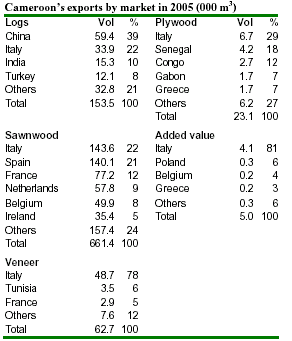
Cameroon's log exports were stable at 153,468 m3 in 2005. China overtook Italy as Cameroon¡¯s main log export destination that year with India also rapidly gaining ground. Sawnwood was
Cameroon¡¯s main timber export product with exports of 661,394 m3 in 2005, down 3% from
2004. The EU, notably Italy, remained the largest destination market. Veneer exports reached 62,736 m3, up 29% from 2004. Italy absorbed 78% of Cameroon¡¯s veneer exports. Plywood exports were 23,103 m3, up 2% from 2004. Italy remained the largest plywood importer while Senegal overtook Rep. of Congo as Cameroon¡¯s second largest plywood importer. The exports of added-value
timber products, such as further processed sawnwood (e.g. mouldings), reached 4,992 m3, up
12% from 2004. About 81% of the exports went to Italy.
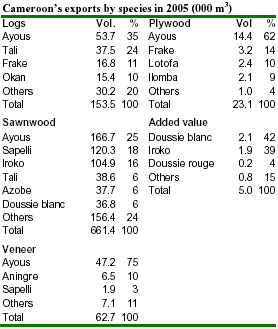
Ayous, sapelli and iroko remained by far the main export species. However, the share of ayous in log exports is rapidly declining as more amounts are diverted in further processing. The strong dependency on this species revealed by COMCAM has prompted authorities to propose some regeneration and plantation programmes as well as the promotion of lesser-known species (LKS). The export of LKS, such as tali and okan, increased over
400% and 500%, respectively, in 2005.
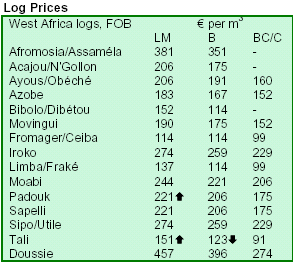
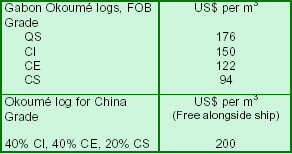
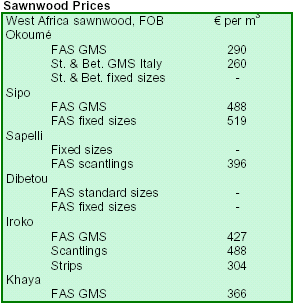
2. GHANA
HIPC funds for forest plantations
Ghana has released GC50 billion ($5.5 million) from the country¡¯s HIPC (Highly Indebted Poor Country) Fund for the Forestry Commission to undertake a forest plantation project this year. The amount is to enable the Plantations Department of the Forestry Services Division (PD-FSD) to expand plantation projects country-wide and generate employment. It is estimated that about 70,000 job vacancies would be created. Mr. Francis Amoah, head of the PD-FSD, hinted that the government would make available around 20,000 hectares of land for the project.
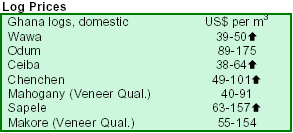
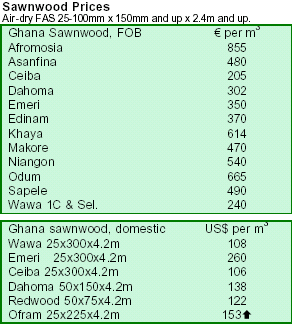
3.
MALAYSIA
Prices rise across the board
Prices for all timber products, from logs to added-value products, surged in late January due to reduced supply of these products as Southeast Asia breaks for lunar New-Year holidays. Furthermore, monsoon rains continued to affect logging and sawmilling operations in the major production areas.
Malaysia to issue bonds for forest replanting
Malaysia, one of the world's largest exporters of tropical hardwood, is planning the first issue of agricultural bonds, according to the Minister Commodities and Plantation Industries, Datuk Peter Chin.
The purpose of the so-called green bonds is to finance forest plantations. The Minister said the government had approved a 15-year bond issue,worth up to 2 billion ringgit ($533 million), to cover forest replanting over an area of 375,000 hectares. The Ministry is working with a 15-year cycle of fast-growing species that will be commercially available when the bonds reach maturity.
The Minister said that banks were not willing to fund projects of this kind as the private sector preferred short-term investments to recover their capital faster.
The Minister stressed that Malaysia requires about 5 million m3 of timber a year, but its deficit supply stands at only 4.5 million m3. The current area under forest is about 310,000 hectares. According to latest national statistics, Malaysia exported about 15 billion ringgit of logs and timber products in 2004.
Rubberwood shortage affecting furniture sector
The ongoing long rainy season could hurt this year's furniture export growth as it aggravates the shortage of rubberwood, the main raw material for furniture makers, according to the Malaysia Furniture Entrepreneur Association
(MFEA).
Despite the Government's imposition of a total ban on rubberwood log exports and an export quota on rubberwood sawnwood, MFEA reports that many of its members still face a shortage of rubberwood. The prolonged rainy season is worsening the situation. MFAE says that the price of rubberwood has increased by 50 ringgit per ton/week in the last months. Prices of rubberwood now stand well above 1,500 ringgit per ton. The last time such a high raw
material cost occurred was in June 2005.
In addition to bad weather, rubberwood supply is being also affected by prices of natural rubber,which are rising along with prices of oil-based synthetic rubber. This has persuaded rubber planters to continue tapping their rubber trees and delaying replanting, resulting in reduced rubberwood log supply for furniture manufacturers.
Rubberwood is also demanded by other timber product sectors such as mouldings, MDF,
chipboard, parquet flooring, plywood and veneer. The MDF and chipboard sectors alone consume as much as 6,000 ton of rubberwood per day. In the past, they used waste wood and off-cuts, but now they are competing directly with traditional furniture makers for rubberwood.
The Malaysian Timber Industry Board (MTIB) has the task of facilitating the distribution of
rubberwood sawntimber to ensure continuous availability, monitoring the stock level and
submitting a monthly report to the Cabinet. Despite the frustrations of furniture manufacturers, MTIB'
role is hampered by factors beyond control such as the weather.
Designation of ports to combat illegal logging The Malaysian deputy prime minister, Seri Najib Tun Razak, who chaired the recent 34th general border committee Malaysia-Indonesia, said the countries were currently identifying ports to be used by Malaysia and Indonesia , in an effort to halt the export of illegal logs.
He said that logs shipped from non-designated ports would be declared as illegal. The move is particularly designed to help cut illegal log exports from Kalimantan to Sabah and Sarawak.
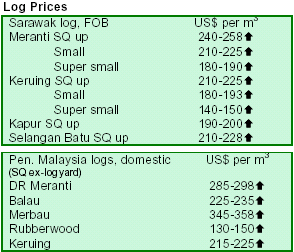
Pen.
Malaysian meranti logs are top grade and are used for
scantlings for the EU. Their prices are higher than
Sarawak's.
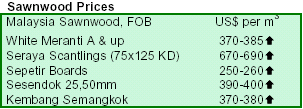
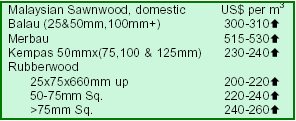
4.
INDONESIA
Proceeds from seized logs for restoration
In a recent workshop on the eradication of illegal logging, the Indonesian Forestry Minister M.S. Kaban indicated that the proceeds from the auction of logs seized from wood illegal loggers in Riau Province, Sumatra, will be used entirely for the rehabilitation and restoration of national forests, which have been badly damaged.
The workshop, attended by civil and police authorities as well as by students, included other speakers such as the head of the criminal investigation body of the Indonesian Police, Mr.Makbul Padmanegara and Riau¡¯s Governor, Mr.Rusli Zainal. Mr. Zainal explained the task and role of the illegal logging eradication team, which is
headed by the Province’s Vice-Governor, Mr. Wan Abu
Bakar.
Foreign investment inflows jumped in 2005 Foreign investment inflows to Indonesia jumped to
$8.91 billion in 2005, up 194% from a year earlier,according to data from Indonesia' Investment Coordinating Board (BKPM).
Foreign investments will have a direct impact on the Indonesian forestry industry and timber growing states. The largest part went to the transportation, warehousing and communication sectors with a total value of $2.95 billion in 53 projects. The second largest was the construction sector with $921.9 million in 35 projects.
Jakarta absorbed the largest share of the foreign investments with $3.27 billion in 366 projects,while West Java Province accounted for $2.57 billion in 210 projects. Other provinces included Riau ($796 million in 8 projects), East Java ($702 million in 46 projects) and Banten ($668 million in 78 projects). The investment projects were estimated to employ a total of 156,109 workers last year, up 108% from 2004.
Indonesia may hike power rates up to 100%
The Indonesian government is considering a hike of up to 100% in electricity tariffs for certain groups of customers in the coming months. The government said the hike was an inevitable move to prevent further losses to the state electricity firm PT PLN, reported The Jakarta Post.
According to the National Development Planning Minister Paskah Suzetta, the government was
considering raising rates by less than 7% for households with a power capacity of 450-900 VA
and 83-90% for households with a capacity of 1,300-10,000 VA. With regards to the industry, the calculation is still underway, but for certain groups still to be defined, the increase could be up to 100%. The final figure will be announced by March.
Currently, companies are charged double for electricity used between 6 pm and 10 pm, with
penalties for additional power consumed in peak hours if a company uses more than half of its average usage.
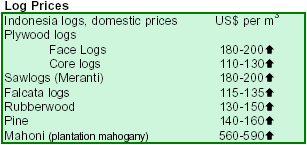
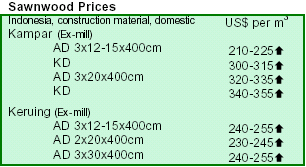
5.
MYANMAR
Teak supply increases
Recently extracted teak logs have started to come to the market and it was hoped that more raw material can be made available for the underfed local wood industry. Log exports remain firm. The market for specialised items , such as teak boards and decking,remain active.
Gurjan log market remains dull
The gurjan market remains dull. Whilst freshly harvested logs have started to come in, Yangon
depots still have large stocks from the previous extraction season. Gurjan may need a different
marketing approach for a quick disposal, as it is not as durable as teak or
pyinkado.
Pyinkado market firm despite price hikes
In January 2006 there was another MTE price increase for pyinkado logs. New pyinkado prices
(US$ per Hoppus ton, FOB Yangon) are at $440 (East Bago area), $430 (West Bago area) and $410 (other areas). Pyinkado seems to perform better than gurjan, with MTE receiving new orders, despite the latest price increase. But generally, hardwood market conditions remain the same as in previous months.
The table below shows FOB average prices Yangon for various grades of teak logs sold by the Myanmar Timber Enterprise (MTE) at their sealed tender held on 20 January and tender held on 23 January 2006.
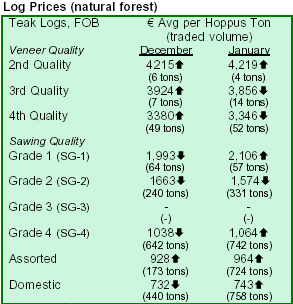
Hoppus ton=1.8m3; All grades, except SG-3, assorted and domestic, are length
8'x
girth 5'and up. SG-3 is girth 4?and up while assorted and domestic are girth
4'and up. SG-3 grade is higher than SG- 4 but with lower girth and price.
6. PAPUA
NEW GUINEA
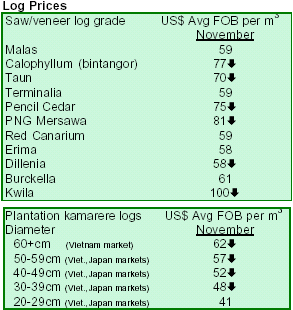
7.
BRAZIL
Domestic prices decline as real strengthens
Domestic prices of solid wood products remained stable in real terms, but declined almost 5% in dollar terms due mostly to the appreciation of the Brazilian currency with respect to the US dollar.
The COPOM (Economic Policy Committee) announced the greatest reduction of the SELIC
(Official interest rate) over a year, from 18% to 17.25%. This reduction of 0.75 percent points was due to the low industrial activity observed in 2005 and the fact that the Brazilian inflation rate (5.1%) was close to the target rate set by the Brazilian Central Bank (BCB, 5.1%). The BCB has changed the regularity of the meetings to revise the SELIC
rate from monthly to every 45 days.
New furniture cluster in the Brazilian Amazon
The government of the State of Amazonas, in partnership with SUFRA (the Supervision of the
Duty Free Zone of Manaus), will invest 10.5 million real in the establishment of a furniture cluster.
The furniture cluster will have an area of 105,000 m2, sheltering 24 small- and micro-furniture companies that will be selected by a bid process. The cluster is expected to be completed by October 2006, creating 500 new jobs in the first year of activit ies. The cluster will have a technological centre for the training of 500 professionals every
two years in the areas of wood technology, painting and woodworking. The cluster will also offer entrepreneurial support to the development of the furniture industry state-wide.
According to AIMAZON (Association of the Furniture Industry of the Amazonas State) there are
nearly 350 furniture companies in the state, most operating without the appropriate legal and technological level. With the new furniture cluster, the state expects to develop and consolidate the wood-furniture segment.
Ibama plans plantations in degraded areas
IBAMA (the Brazilian Institute for Environment and Natural Resources) plans to establish 1.8
million ha of forest plantations in the State of Para over a six-year period. Such area represents 10% of the State's total degraded land area with high productiv ity potential. The plan is part of the new reforestation program from IBAMA, which will focus especially in Legal Reserve Areas (ARL).
According to IBAMA, the State of Para has about 200,000 ha of planted forest. About 75% of the reforestation projects of the state were established in areas degraded by extensive cattle raising and slash-and-burn agriculture. Extensive cattle raising is estimated to account for 80% of the state's land degradation.
The National Institute of Spatial Researches (INPE) reported that between 2001 and 2002 about 25,000 km2 were deforested in the State of Para. This area corresponded to almost 16% of the deforested area in the Brazilian Amazon. For 2004-2005, INPE reported a decline in deforestation to 18,000 km2, down 31% from the previous biennium.
The first part of the programme intends to establish 200,000 ha with forest plantations. The main purpose of the programme is to transform the socalled "Arc of Deforestation" into an "Arc of Reforestation". About 70% of all deforestation in the last 5 years in the northeast, southeast and southern part of the state of Par¨¢ was concentrated in the ¡°Arc of Deforestation".
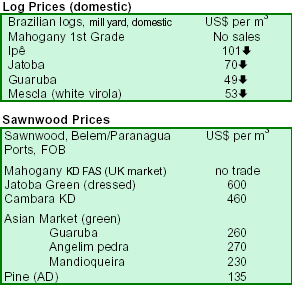
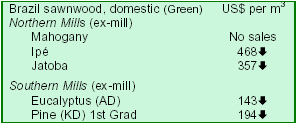
8. PERU
Peru announces 2006 mahogany export quota
Peru¡¯s INRENA established the mahogany export quota for 2006 at 23,239.57 m3, down 1.6% from 23,621 m3 in 2005. The decision, announced on 29 January, was reached after technical evaluations and analysis of volumes mobilized from forest areas with approved Annual Operative Plans. Timber trade representatives and government authorities had been holding discussions on the quota since 16 January 2006.
Peruvian exports reached $169 million in 2005
Preliminary statistics show that Peruvian exports of timber and timber products reached $169 million in 2005, up 24% from 2004 but below the projected $180 million. Analysts name two main factors that prevented greater exports. Firstly, the financial problems faced by 90% of the forest concessions (see MIS Report 10/20). Secondly, the ongoing crackdown on illegal logging that has reduced the availability of raw material.
The USA remains Peru¡¯s major trading partner (42% of exports), followed by Mexico (34%) and
China (12%, excluding Hong Kong S.A.R.). The composition of exports has varied significantly in the last years. While in 2000-2003 exports were led by raw materials (notably mahogany and virola sawnwood), in 2004-2005 exports of further processed products, such as blanks and friezes (up 80%), veneer (up 44%) and plywood (up 30%), are becoming increasingly important. However,sawnwood still accounted for 57% of the exports in 2005.
Peruvian products compete with Chilean pine
ACE Home Center Peru, a DIY retailer, has introduced standardized Peruvian tropical wood
products in the country¡¯s shops. The introduction of plywood, sawnwood and timber laths was due to demand from the construction market, which previously satisfied its needs with radiata pinus products imported from Chile. Customers were demanding wood products with natural resistance to fungus and termite attacks, and better structural resistance.
The products introduced are made up of species such as tornillo (Cedrelinga catenaeformis),
Spanish cedar (Cedrela odorata ), virola (Virola sp.) or bolaina (Guazuma crinita). Although ACE Home is gradually substituting pine products from Chile
with Peruvian products, the former are more readily available since they come from plantations. Chilean products are also more price competitive than tropical timber products.
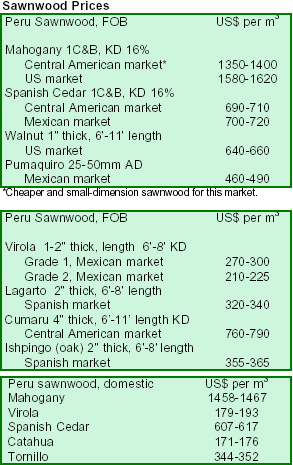
9. BOLIVIA
Introducing prices from Bolivia
With $22.7 million, Bolivia was the third largest exporter of tropical sawnwood in Latin America in 2005, after Brazil and Peru. Main export sawnwood species were mahogany (11.2%), Spanish cedar (10.6%) and South American oak (3.1%).
Bolivia is the world leader in certified natural tropical forests with over 2.2 million ha in 2005 and $16.5 million of exports in 2004. More than 80% of these exports were value-added products such as doors, mouldings, furniture parts and furniture in general, among others. The main markets were the UK and USA (85% of the export value).
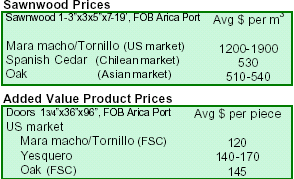
¡¡
10.
Guatemala
Introducing plantation teak prices
Guatemala is an important exporter of timber products from plantation teak.
Plantation teak prices rising steadily
According to ¡°Gremial Forestal¡±, the average FOB prices for teak logs and sawnwood have increased about 8% over the last 8 years.
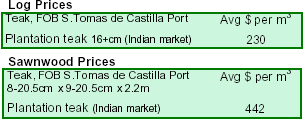
11.
Guyana
Introducing prices from Guyana
With 124,951 m3, Guyana was the second largest exporter of tropical logs in Latin America in 2005, after Ecuador. Guyana was also the region¡¯s third largest exporter of tropical plywood (36,574 m3), after Ecuador and Peru. With 43,020 m3 in 2005, Guyana ranked fourth in the region¡¯s sawnwood exports.
Exports of logs and sawnwood from Guyana are dominated by greenheart, purpleheart, mora and
kabukalli. The major destinations for round logs were India, China, Vietnam, Taiwan P.O.C. and Hong Kong S.A.R. The main markets for sawnwood were the Caribbean (notably Barbados),
the USA and UK.
Plywood exports from Guyana, mostly baromalli plywood, went mainly to the USA, Caribbean and
UK. Recently , the range of species has been expanding to include more lesser-known species, a trend expected to continue.
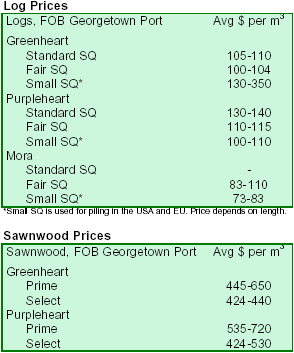
|